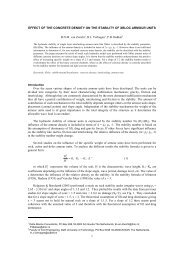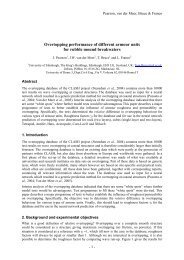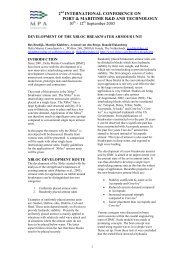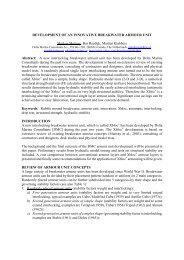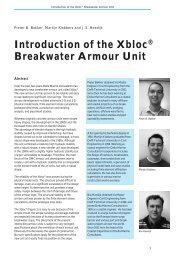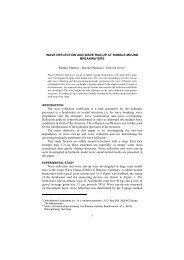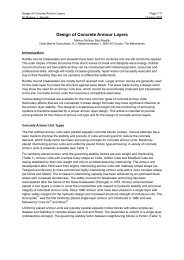Frequently Asked Questions about the Xbloc ® unit [FAQ]
Frequently Asked Questions about the Xbloc ® unit [FAQ]
Frequently Asked Questions about the Xbloc ® unit [FAQ]
Create successful ePaper yourself
Turn your PDF publications into a flip-book with our unique Google optimized e-Paper software.
STRUCTURAL INTEGRITY<br />
What is meant by structural integrity?<br />
Structural integrity is <strong>the</strong> robustness or strength of a single <strong>unit</strong>: <strong>the</strong> resistance of an<br />
armour <strong>unit</strong> against forces due to handling, placement and movement under extreme<br />
wave attack [rocking].<br />
How has <strong>the</strong> structural integrity of <strong>the</strong> <strong>Xbloc</strong> been determined?<br />
The structural integrity of <strong>the</strong> <strong>Xbloc</strong> ® has been determined by Finite Element [FE]<br />
calculations. With <strong>the</strong> aid of FE calculations using standard load cases <strong>the</strong> tensile stresses<br />
in <strong>the</strong> <strong>Xbloc</strong> ® <strong>unit</strong> and o<strong>the</strong>r single layer armour <strong>unit</strong>s were determined. Fur<strong>the</strong>rmore<br />
prototype drop tests have been performed to check <strong>the</strong> validity of <strong>the</strong> calculations.<br />
How does <strong>the</strong> strength of <strong>the</strong> <strong>Xbloc</strong> ® <strong>unit</strong> compare to o<strong>the</strong>r <strong>unit</strong>s?<br />
From both Finite Element calculations as well as prototype drop tests it can be concluded<br />
that <strong>the</strong> maximum tensile stresses in <strong>the</strong> <strong>Xbloc</strong> ® <strong>unit</strong> are certainly no greater than <strong>the</strong><br />
tensile stresses in o<strong>the</strong>r single layer <strong>unit</strong>s. Due to its shape <strong>the</strong> <strong>Xbloc</strong> ® is a robust <strong>unit</strong>.<br />
This requires <strong>the</strong> use of standard non-reinforced concrete with a minimum concrete<br />
tensile strength of only 2.5 N/mm 2 . O<strong>the</strong>r modern single layer armour <strong>unit</strong>s require<br />
concrete with a higher minimum tensile strength.<br />
Why is this strength so important for a <strong>unit</strong>?<br />
During handling and placement <strong>the</strong> <strong>unit</strong> must be strong enough to cope with <strong>the</strong> stresses<br />
imposed. Once placed on <strong>the</strong> breakwater an armour <strong>unit</strong> is subject to wave forces which<br />
can be extremely high during storms. Extreme wave action can cause small movements<br />
[i.e. rocking] of <strong>unit</strong>s. In <strong>the</strong> past this caused failure of o<strong>the</strong>r proprietary armour <strong>unit</strong>s<br />
and subsequent failure of <strong>the</strong> whole breakwater. An armour <strong>unit</strong> should <strong>the</strong>refore be<br />
strong enough to resist all loads that may be expected during <strong>the</strong> lifetime of <strong>the</strong><br />
structure.<br />
What are <strong>the</strong> weak spots of <strong>the</strong> <strong>unit</strong> considering breakage of <strong>the</strong> <strong>unit</strong>?<br />
Following from <strong>the</strong> finite element calculations for certain standard loads it was found that<br />
<strong>the</strong> highest tensile stresses in <strong>the</strong> concrete occur at <strong>the</strong> transition between <strong>the</strong> X-shaped<br />
base and <strong>the</strong> nose. In order to decrease <strong>the</strong> tensile forces a chamfer or fillet has been<br />
introduced between <strong>the</strong> base and <strong>the</strong> nose. The prototype drop tests were however<br />
performed with <strong>unit</strong>s where no chamfer or fillet had been incorporated and even without<br />
<strong>the</strong> improvement <strong>the</strong> strength of <strong>the</strong> <strong>unit</strong> was excellent.<br />
What kind of damage does occur during droptests?<br />
In <strong>the</strong> tests it was found that <strong>the</strong> sharp edges of <strong>the</strong> concrete will crush, leading to a<br />
negligible decrease of <strong>the</strong> <strong>unit</strong> mass. At large fall heights on to a rigid concrete base a<br />
nose or a leg broke off, depending on <strong>the</strong> particular orientation of <strong>the</strong> drop. Stresses<br />
inflicting this kind of damage are not expected to occur during <strong>the</strong> life-time of an <strong>Xbloc</strong> ® .


![Frequently Asked Questions about the Xbloc ® unit [FAQ]](https://img.yumpu.com/24141057/9/500x640/frequently-asked-questions-about-the-xbloc-aar-unit-faq.jpg)
